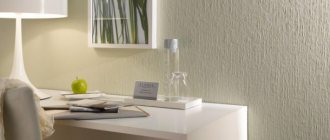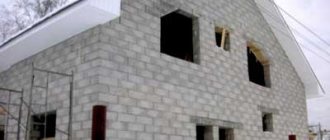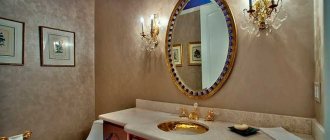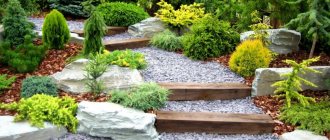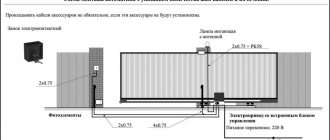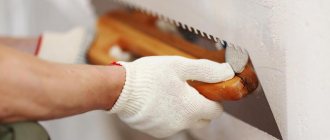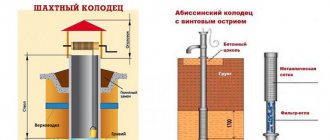Paintable wallpaper has a high level of noise absorption. Painting wallpaper - a couple of decades ago, none of our compatriots could even imagine such a prospect, but today you can transform a wall with your own hands simply by painting the wallpaper. Technology has come so far that this can be done without involving specialists, and you will get a new wall without streaks. You want the most incredible texture and colors of paints, and painting ideas are not limited to a couple of options.
Wallpaper for painting in the interior
For beginners and those who are just delving into the issue, it’s worth saying right away that not all wallpaper needs and can be painted. And even if you bought expensive textured wallpaper, it may not be the type of wallpaper that can be painted. Wallpaper for painting has the required degree of moisture resistance, is distinguished by deep relief, does not have a multi-color pattern and, it happens, contains pigment.
When choosing wallpaper for painting, you should pay special attention to its texture and its compatibility with your future interior
In the interior, such wallpaper can be combined with other coatings, combining textures and colors in every possible way
Choice of paint coating
Popular are easy-to-use, simple compositions on water:
- latex;
- acrylic;
- water-based;
- water-dispersed.
Sometimes alkyd solutions with oils and resins can be used.
The composition of the water-based emulsion coating includes:
- latex;
- fillers;
- fastening elements;
- antiseptic;
- chemical substances.
According to environmental standards, it can be used in places where people permanently reside. This is a moisture-resistant, odorless, non-allergenic solution that can be washed with a damp cloth without damaging the surface.
Silicone-based water-based paint is used in the kitchen and bathroom in conditions of high humidity. It differs from the acrylic composition in small fractions. The latter does not contain chemical or hazardous components, so it is widely used in living rooms. Acrylic compounds are odorless, allow the wallpaper to breathe, and do not collect fumes on its surface. Drying time is 24 hours. The coating is intended for non-woven surfaces, but manufacturers produce compositions for fiberglass and paper wallpaper.
Bright interior of a children's room
Latex solution is made with water-based latex. Styrene butadiene and acrylic latex can be used. This is a material with high elasticity, long-term use, and is presented in white color, so tinting is used . Soft shades are formed, since in practice it is impossible to achieve sharp tones. Latex paint is intended for glass wallpaper and non-woven coatings with a relief structure. Latex has a slight odor and is suitable for utility areas and living rooms, except for rooms with high humidity.
After applying alkyd solutions, a strong film appears that is resistant to frequent washing. The products are mainly used in the finishing of non-residential and ancillary buildings with fiberglass coatings. The disadvantage is the content of resins and oils in the composition, which can negatively affect health and the respiratory tract. Such walls cannot breathe; condensation forms on them.
Combination of white and light green
Paint color
In order for glued canvases to become a decoration of the room, you need to make the right choice of shade and know the reflective properties of the paint. Initially, the canvases are colorless with different surfaces. First, they can be painted in any shades, mainly light ones. In living rooms, pastel colors are chosen; a delicate shade can be obtained by tinting.
When tinting at home, it is impossible to get the same shade in different containers, so computer color selection is offered. Tinting equipment will produce paint in the required range, it will be the same even in different containers. Even if the resulting volume is not enough, the tinting unit can produce the required volume of paintwork with an exact color match.
Interesting room for a boy
You also need to remember that each paint has its own reflective ability:
- Gloss . Has a sheen that reflects light. It is advisable to use it in the decoration of northern rooms, but not in southern ones with bright lighting.
- Semi-gloss . It features optimal light reflection and is used in many rooms, reflecting uneven walls (the base must first be leveled).
- Semi-matte . It has low reflective ability, well suited for the living room and bedroom.
- Satin . It reflects light strongly and glare appears in artificial lighting. Suitable for finishing bathrooms and kitchens.
Bright room for children
Paintable wallpaper: pros and cons
When considering different options, you, as a buyer, evaluate the pros and cons of a potential acquisition. And this is reasonable, because it is correct to evaluate all sides.
"Pros" of wallpaper for painting:
- The ability to repaint the wallpaper several times, thus updating it;
- Wallpaper is highly resistant to ultraviolet radiation;
- Wallpaper masks wall defects;
- You can paint it in any color - a rich palette of choices creates unique possibilities in the interior.
Paintable wallpaper is charming because it allows you to liven up the interior without undertaking a grandiose renovation. High-quality wallpaper can withstand up to 10 dyeing cycles
"Disadvantages" of wallpaper for painting:
- Some types of wallpaper require particularly delicate care;
- You will have to purchase additional paint.
And these are just the main qualities of wallpaper. Before purchasing, read not only reviews, but also the technical qualities of the wallpaper.
Types and advantages of wallpaper for painting (video)
Paintable wallpaper: technical specifications
Usually you buy wallpaper, imagining exactly how it will look in your interior. Here is another option - wallpaper for painting is available in neutral colors; the manufacturer can add a little white pigment so that painting occurs on a light base.
Related article: How to properly make a dryer for vegetables and fruits with your own hands
Other wallpaper characteristics:
- Rarely are such wallpapers glossy. Smooth options, of course, are found, but glossy ones are almost never. Why? It's simple: matte and semi-matte textures guarantee better adhesion to the paint and varnish composition.
- The relief surface is the main feature of such wallpapers; thanks to it, after applying color, the wallpaper becomes as attractive as possible.
There is wallpaper with a 3D effect, one of the most modern types. These are rolls with a very deep relief, which after painting create the illusion of a three-dimensional image
If, however, textured wallpaper is not what you want, then there is a relatively smooth option with a fine-grained surface.
Paper wallpaper: main characteristics
Paper wallpaper consists of two (sometimes three) layers, between which sawdust is placed. Thanks to these elements, the wallpaper acquires relief. Sawdust is placed chaotically and often creates the most intricate texture that can satisfy the needs of even the most demanding client. The top layer of paper wallpaper is usually impregnated with a water-repellent composition. This ensures a high level of moisture resistance and strength.
The main advantages of paper wallpaper are compliance with all environmental standards, a wide range of textures and low cost. When gluing this type of wallpaper, special care is required: folds or stretches may form on it due to the fact that the glue is applied directly to the canvas. The maximum number of colors that paper wallpaper can withstand is five. But if the texture of the material is weakly expressed, after the third painting the surface becomes almost flat. Paper wallpaper also requires delicate handling. Any mechanical damage must be promptly restored, and this significantly reduces the service life of the wallpaper.
How to properly glue non-woven wallpaper
Which wallpaper is better for painting: types
Wallpaper intended for painting can be of three types - paper wallpaper, non-woven wallpaper and fiberglass wallpaper. It’s worth considering all three types, and you’ll decide which wallpaper is best for painting.
Characteristics of wallpaper types:
- Paper. They are produced in two versions - simplex (this is a single-layer coating, cheap wallpaper, easy to install, but not so durable), duplex (two-layer wallpaper, with a thick bottom sheet and a thin top, decorative one). Here you can also remember about coarse-fiber trellises; during production, small wood shavings are added to the material, resulting in an outwardly rough canvas or covering similar to burlap.
- Non-woven . A worthy alternative to paper wallpaper, non-woven fabric is also used in the clothing industry, so your wallpaper can be considered textile. Such wallpaper is chosen if you need to mask some surface irregularities. If the defect is no more than 5mm, the spongy structure of the wallpaper will cover it. In addition, non-woven fabric has good vapor permeability and breathability, which is an excellent quality - natural ventilation is not disturbed.
- Glass wallpaper . Completely inorganic material has to be used for their production. Another name for wallpaper is fiberglass. This is a structural modern wallpaper, which is obtained as follows: fibers are drawn from molten glass, and then they are combined into a canvas. Fiberglass wallpaper is made from canvas and can be painted: there is wallpaper with texture, there is wallpaper without texture. This type of wallpaper is not at all afraid of fungi.
Unlike non-woven wallpaper, paintable paper wallpapers are less resistant; they can withstand a maximum of 2 – 3 painting cycles
It is worth noting that although the latter type of wallpaper looks beautiful, and the quality certificate for such wallpaper usually speaks for itself, the choice has to be made towards other options, since glass wallpaper is very expensive.
Types of wallpaper for painting (video review)
Appearance
From all the variety of wall coverings now offered in construction stores, it is important to choose wallpaper that not only appeals to you in terms of design. It is important to choose a type that matches the characteristics of the rooms where you plan to cover the walls with them. Then you need to understand whether the walls will be covered completely or will be applied in fragments. Price is also important as a characteristic of this finishing material.
The following types are currently used for interior decoration::
- paper;
- non-woven;
- vinyl;
- acrylic;
- textile;
- glass wallpaper;
- liquid coatings;
- coverings made from natural materials (bamboo, cork, grass stems);
- metallized;
- wallpaper for painting.
Knowing the information about what coatings are made of and their properties, it is easy to select the necessary types based on the functionality of the room. You can distinguish different types of wallpaper from each other by their visual characteristics.
Non-woven
Non-woven wallpaper is so called because its basis is non-woven fabric - non-woven fabric. It consists of cellulose or artificial fibers. The structure is fabric fibers mixed with paper. There are completely non-woven ones, others have only a base. Their top layer is made of other materials. It is made in different densities, it allows moisture to pass through well. Due to their elasticity, they fit well even on uneven walls and mask unevenness and defects well.
They are popular and have the following advantages:
- this type of coating does not swell from glue and moisture;
- non-woven wallpaper can be glued to walls with slight irregularities;
- the canvas does not deform, does not tear when the walls shrink or cracks form on them;
- are able to reduce the sound permeability of walls and heat loss;
- environmentally friendly;
- does not shrink after drying;
- dust is not absorbed into their surface;
- resistant to fading;
- fire resistant.
Like any material, non-woven wall coverings have a number of disadvantages :
- difficult to maintain, difficult to remove dirt and dust from reliefs;
- relatively high cost;
- Unresistant to piercing and cutting objects.
Important
Fully non-woven wallpaper can rarely be found on sale. More often you can find wall coverings with a combination of non-woven and vinyl layers.
You will learn more about the properties of non-woven wallpaper from this video:
Vinyl
Vinyl wall coverings are available on paper or non-woven backing. A layer of polyvinyl chloride (PVC) is applied on top of the base. Its other name is vinyl. Its thickness is less than one millimeter, but it makes this type of coating very durable. They come in the following varieties:
- silkscreen printing;
- hot stamping.
They can be washed and cleaned with a brush. Canvases are used to cover rooms with high levels of humidity (bathroom, kitchen, toilet) and in rooms with increased mechanical load on the walls (hallway, corridors).
This type of coating has the following advantages:
- can be washed and cleaned, dirt can be easily removed from them;
- resistance to detergents;
- moisture resistance, strength;
- affordable prices;
- interesting, non-standard design;
- do not fade under the influence of direct sunlight.
Attention
The negative qualities of this wallpaper include airtightness. They cannot be used to paste over walls in the nursery and bedroom. Coatings may come apart at joints as they can stretch depending on humidity levels. They also have an unpleasant chemical smell.
We invite you to watch a useful video about the features of vinyl wallpaper:
The features and types of vinyl wallpaper and step-by-step instructions for gluing them can be found here, and this article talks about how to easily and quickly remove the old covering from the wall.
Paper
These wall coverings can be found more often than others, since these coverings have a low price and are environmentally friendly. They are produced in single-layer and double-layer. The surface is often smooth, less often coatings with shallow relief are produced. Various designs are applied to it, and embossing is also possible.
This type of wall covering has the following advantages:
- affordable price;
- allow air and moisture to pass through, the walls do not get wet, since the wallpaper is able to breathe;
- they are easy to stick on walls;
- environmentally friendly.
Coatings also have disadvantages, which depend on the quality of the paper, thickness and number of layers.
Disadvantages of coatings:
- fragility, easily torn;
- in places subject to abrasion, light spots quickly appear;
- cannot be washed or wiped to remove dirt;
- the design fades quickly when exposed to direct sunlight;
- quickly absorb odors.
Advice
The service life of paper wallpaper is no more than five years.
The characteristics of paper wallpaper are described in detail in this video:
For painting
This type of wall covering is often used to decorate residential premises. They are easy to wash, maintenance is simple and easy. You can repaint it several times in different colors if desired. Therefore, wallpaper for painting is produced by manufacturers only in white . They have an affordable price.
These coverings come in several types and differ in the material from which they were made. Varieties:
- non-woven;
- fiberglass coverings;
- paper;
- based on plant materials;
- vinyl.
They come with a smooth and structured surface. There are especially durable anti-vandal wall coverings.
Their features are distinguished by the following::
- have special strength;
- they can be easily repainted in any color (from five to fifteen times depending on the manufacturer);
- long service life;
- you can paste over the ceiling;
- mask even large defects;
- there is no need to prepare the wall surface before wallpapering;
- They hide uneven walls well.
Among the minuses:
- difficulty in preparing coatings before painting;
- they have a high price;
- the number of colors depends on the severity of the pattern’s relief.
You will find more information about which wallpaper to choose for painting in this useful video:
Paintable wallpaper: reviews
It is worth understanding that reviews may be different, even based on how the gluing and painting work was carried out. Someone could ruin the whole picture with their own hands simply by choosing the wrong paint.
By the way, about which paint to choose - here you can refer to the reviews. Painting should be done only with water-based products. Most often they choose the usual water-based emulsion and acrylic paints. The second option is preferable, since acrylic paints do not contain solvents or other harmful substances.
Judging by numerous reviews, including experts, a good choice is latex dispersion paint
Article on the topic: Crafts for the garden from scrap materials (60 photos)
Latex dispersion paint is safe for human health. As soon as the paint is opened, you need to dilute it with water and apply it to the surface. After painting, the wall dries for about three days. A liter of diluted paint, according to reviews, is enough for six meters of area.
What is glass wallpaper?
Fiberglass is a type of rolled finishing material that is produced on the basis of fiberglass threads.
In fact, it is a thin fabric, the structure of which consists of a chaotic interweaving of fiberglass threads. These fibers are produced by melting a special type of glass and drawing a thin thread from the resulting mass. Modern production makes it possible to obtain a thread that, when broken, does not form dust-like fragments. Special starch-based impregnations increase the strength and durability of the material. Thus, fiberglass wallpaper is absolutely safe both when gluing and during use.
Glass wallpaper is produced using special equipment. It allows you to obtain fabric of different densities and with any decorative pattern. Glass wallpapers of the following types are available for sale:
- Gossamer;
- With diamond weave;
- In the form of squares;
- Matting of different sizes and others.
Thanks to a wide range of models, everyone can choose the appropriate texture based on the design concept, interior style and room area.
Design of a room with wallpaper for painting
Designers say that not only color, but texture is important. Texture is the relief of the wallpaper surface, which creates a certain pattern, forms grooves, bulges, cracks, etc.
And there are some tricks here; you can make completely different walls in the interior with your own hands. In this case, you can use the same wallpaper for painting.
Wallpaper design features:
- A correct, almost mathematically precise pattern creates the effect of a monotonous wall (a good option for an office);
- A too chaotic pattern will create the effect of a rough, even unkempt wall;
- A soft pattern will be obtained if the texture is finer and seamless;
- The “matting” pattern is very popular, and it is suitable for those who like simple solutions, and the most popular colors in this case are beige and brown;
- The herringbone pattern should not be used in the interior of a small room; its size will visually decrease further.
Simple elements and straight lines create a slightly boring image, which is not appropriate in every interior.
Ultimately, everything will depend on the paint job. “Painting” works will turn neutral wallpaper into colorful ones and completely transform the design of your room.
How to paint high-quality wallpaper in a room
Painting is impossible without a paint roller, a paint pan, a small brush, and a clean cotton rag. The procedure begins after the glue has completely dried, the air temperature is 17-25°.
Step-by-step instructions for high-quality painting:
- Remove or cover furniture with film. Seal joints with doorways, window sills, and baseboards with masking tape.
- Place the rollers in a soapy solution of warm water, wring them out and rinse with clean water - the fibers will not stick to the paint. You can roll the rollers using masking tape.
- Use a brush to paint 10 cm from the ceiling around the perimeter of the room. And then - from the floor.
- Also treat the relief elements and corners with a brush.
- Using a large roller, paint the wall surface from top to bottom, without holding the tool in one place. If necessary, apply a second layer (after the first has dried).
When you want to paint a wall in different colors, use masking tape or pink tape for delicate surfaces. The color line will be clear, the canvas will not deteriorate. Remove the tape when the paint has dried.
Paintable wallpaper: how to paint
You can paint such wallpaper yourself, but if you, for example, use fiberglass or another expensive option, it makes sense to turn to specialists.
Using simple tape you can create a vertical pattern on the wallpaper, and using stencils allows you to make unique prints with your own hands
Wallpaper painting:
- Make sure that the wallpaper is completely dry and has not peeled off anywhere, neither in the joints nor in difficult corners;
- Before diluting all the paint, do a color test in an inconspicuous place, if you like everything, continue;
- Paint the wall with a roller or spray (which is the best roller to paint - velor);
- Painting with a spray gun is an ideal option, since you can apply about 10 layers to the wall, but the roller can only withstand 6, maximum 8;
- Use a brush to paint only hard-to-reach areas.
It is worth mentioning this type of wallpaper as anti-vandal. This option is a joy for young parents and cat owners. Roughly speaking, this is an unusually wear-resistant wallpaper that is not afraid of scratches or children’s “rock painting” with some sharp object. And they need to be painted the same way as all other types.
Related article: How to eliminate condensation on a metal entrance door
How to properly paint wallpaper for painting (video)
Paint selection
To ensure that the environmental component of the house is not compromised after renovation, it is worth purchasing adhesives and paints and varnishes that do not contain toxic chemical components.
Purchasing paint for wallpaper, like purchasing any things, is a responsible process, since the final result directly depends on the quality of the paint and varnish material. Acrylic, water-based or latex paints are considered the most suitable.
You can choose the desired shade or do the tinting yourself. By the way, now many building materials stores have equipment that allows you to mix colors without effort.
Stencils for wallpaper for painting
If you decide to highlight one area of the room with an ornament, you don’t need to look for similar wallpaper, just with a pattern. It is enough to purchase a special stencil that is applied to the wall, and you paint a certain fragment yourself.
A single-color stencil and a contrasting color can unusually enliven the interior, adding a special touch to it
Types of stencils:
- Plain. Simple, beautiful, accurate and fast.
- Multicolor. It is more difficult to do polycolor, but such work also looks more impressive. In this case, you will need more stencil blanks.
- Volumetric. In this case, you no longer need to use paint, but a special putty, which is not the best option for wallpaper.
- Reverse . Used for lighting effect. In this embodiment, the surface is painted outside the mold.
Do not take stencils with a lot of small details; the stencil should be concise.
Which is better: wallpaper or paintable wallpaper?
It is difficult to give an objective answer. It depends on what final effect you are interested in. It’s worth starting by answering the question - how many times can such wallpaper be painted (meaning, before painting). Experts assure that good wallpaper can withstand up to ten repaints. Needless to say, it's impressive - you can change the color of the walls almost ten times.
Everyone should determine which wallpaper is best to choose for themselves, since everyone has their own priorities in interior design
The main thing is that you need to decide what is more important to you – color or pattern. If you are attentive to detail, then a pattern is definitely preferable, which means you should choose simple wallpaper. If you perceive everything as a whole and delve into small details, then take wallpaper that can be repainted.
Comparison of characteristics
A comparative analysis of wallpaper characteristics is presented in the table.
| Properties | Paper | Vinyl | Non-woven | Wallpaper for painting |
| Wear resistance | + | +++ | ++ | ++++ |
| Moisture resistance | + | ++++ | ++ | +++ |
| Ability to breathe | ++++ | + | ++ | +++ |
| Ability to hide defects | + | ++ | +++ | ++++ |
| Design | + | ++++ | ++ | +++ |
| Heat and sound insulation | + | +++ | ++++ | +++ |
| Resistant to fading | + | ++++ | ++ | +++ |
| Ease of the process of gluing walls | ++ | + | ++++ | +++ |
| Is it possible to wash | + | ++++ | ++ | +++ |
| Abrasion resistance | + | ++++ | ++ | +++ |
| Unpleasant smell | + | ++++ | ++ | +++ |
| Environmental friendliness | ++++ | + | +++ | ++ |
| Pattern stability | + | ++++ | +++ | ++ |
- «+» – minimal severity of the sign;
- «++++» – maximum severity of the trait.
These characteristics of the wallpaper determine in which room it is best to paste it.
